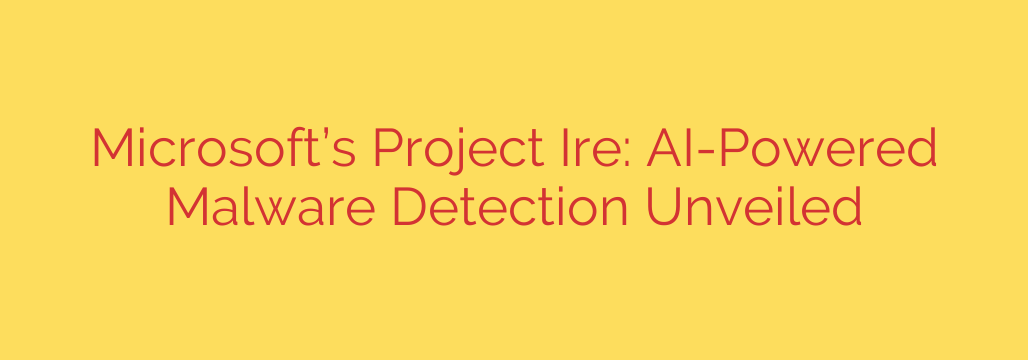
The Next Wave of Cyber Defense: How AI is Revolutionizing Malware Detection
The digital world is locked in a perpetual arms race. As our defenses get stronger, cybercriminals develop more sophisticated tools to bypass them. Traditional security methods, while still valuable, are struggling to keep up with the sheer volume and complexity of modern threats. This is where Artificial Intelligence (AI) is stepping in, not just as an incremental improvement, but as a revolutionary force in the fight against malware.
In a landscape where new threats emerge daily, a new, proactive approach is essential. Microsoft has been at the forefront of this evolution, developing advanced AI systems designed to hunt down malicious software before it can cause widespread damage.
The Limits of Traditional Antivirus
For decades, the primary method for detecting malware has been signature-based detection. Think of it like a digital fingerprint database. When a new virus is identified, security experts analyze it and create a unique “signature.” Your antivirus software then scans files on your computer, comparing them against its massive library of known signatures. If it finds a match, it quarantines the threat.
This method works well for known viruses, but it has a critical weakness: it’s entirely reactive. It cannot identify a threat it has never seen before. Cybercriminals exploit this by creating:
- Polymorphic Malware: This type of malware constantly changes its own code to create new, unique signatures for each infection, making it invisible to traditional scanners.
- Zero-Day Exploits: These are attacks that take advantage of a security vulnerability on the very same day it becomes known to the public, before developers have had a chance to release a patch.
How AI Changes the Game in Cybersecurity
Instead of looking for a known fingerprint, AI-powered security focuses on behavior. It uses sophisticated machine learning models trained on trillions of data points—from benign software to the most dangerous malware—to learn what normal system activity looks like.
When it analyzes a new program, it doesn’t just ask, “Have I seen you before?” It asks, “Are you behaving suspiciously?”
This behavioral analysis allows AI to spot the tell-tale signs of a malicious attack, even from a brand-new piece of malware. It can identify patterns that would be invisible to a human analyst, such as:
- A program attempting to access sensitive files it shouldn’t.
- An application trying to encrypt files in the background (a hallmark of ransomware).
- Unusual network communication to a suspicious server.
By focusing on intent and action rather than a static signature, AI can detect and neutralize threats proactively, often stopping an attack in its earliest stages.
The Power of Predictive Defense
The latest AI security models go beyond simple detection. They leverage predictive capabilities to anticipate threats. By analyzing global threat intelligence data in real-time, these systems can identify emerging attack campaigns and pre-emptively strengthen defenses against them.
This technology is a core component of modern security platforms, including Microsoft Defender. By integrating AI directly into the operating system and cloud services, it provides a powerful, multi-layered defense that can analyze signals from endpoints, emails, and cloud applications to get a complete picture of an organization’s security posture.
The key benefit is its speed and scale. An AI model can process billions of signals in seconds, a task that would be impossible for even the largest team of human security experts. This allows for near-instantaneous protection against emerging threats across the globe.
Actionable Steps to Enhance Your Security
While advanced AI is working in the background, there are crucial steps every user and organization should take to maintain a strong security posture.
- Enable AI-Powered Features: Ensure that the AI and cloud-delivered protection features in your security software (like Microsoft Defender or other next-gen antivirus solutions) are turned on. These are often the features that provide proactive, behavioral-based detection.
- Keep Everything Updated: The fastest way to fall victim to an attack is by running outdated software. Enable automatic updates for your operating system, web browser, and all applications to ensure security vulnerabilities are patched as quickly as possible.
- Practice Smart Security Hygiene: Educate yourself and your team about the dangers of phishing emails, suspicious links, and unverified downloads. User awareness is a critical layer of defense that technology alone cannot replace.
- Implement Multi-Factor Authentication (MFA): One of the most effective ways to protect your accounts is to enable MFA wherever possible. This ensures that even if a password is stolen, attackers cannot gain access without a second form of verification.
The fight against cybercrime is evolving rapidly, and AI has become our most powerful ally. By shifting from a reactive to a predictive defense model, we can better protect our data and systems from the next generation of digital threats.
Source: https://securityaffairs.com/180908/malware/microsoft-unveils-project-ire-ai-that-autonomously-detects-malware.html








